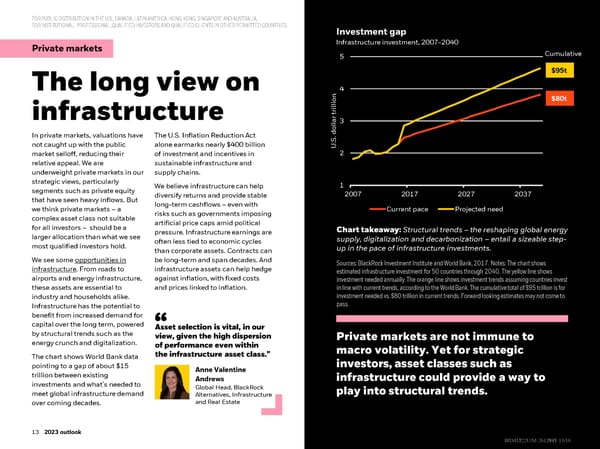FOR PUBLIC DISTRIBUTION IN THE U.S., CANADA, LATIN AMERICA, HONGKONG, SINGAPORE AND AUSTRALIA. FOR INSTITUTIONAL, PROFESSIONAL, QUALIFIED INVESTORS AND QUALIFIED CLIENTS IN OTHER PERMITTED COUNTRIES. Investment gap Private markets Infrastructure investment, 2007-2040 5 Cumulative The long view on $95t 4 onilli $80t infrastructure tr arl3 In private markets, valuations have The U.S. Inflation Reduction Act S.dol not caught up with the public alone earmarks nearly $400 billion U. market selloff, reducing their of investment and incentives in 2 relative appeal. We are sustainable infrastructure and underweight private markets in our supply chains. strategic views, particularly We believe infrastructure can help 1 segments such as private equity diversify returns and provide stable 2007 2017 2027 2037 that have seen heavy inflows. But long-term cashflows –even with we think private markets – a risks such as governments imposing Current pace Projected need complex asset class not suitable artificial price caps amid political for all investors – should be a pressure. Infrastructure earnings are Chart takeaway: Structural trends –the reshaping global energy larger allocation than what we see often less tied to economic cycles supply, digitalization and decarbonization – entail a sizeable step- most qualified investors hold. than corporate assets. Contracts can up in the pace of infrastructure investments. We see some opportunities in be long-term and span decades. And Sources: BlackRock Investment Institute and World Bank, 2017. Notes: The chart shows infrastructure. From roads to infrastructure assets can help hedge estimated infrastructure investment for 50 countries through 2040. The yellow line shows airports and energy infrastructure, against inflation, with fixed costs investment needed annually. The orange line shows investment trends assuming countries invest these assets are essential to and prices linked to inflation. in line with current trends, according to the World Bank. The cumulative total of $95 trillion is for industry and households alike. investment needed vs. $80 trillion in current trends. Forward looking estimates may not come to Infrastructure has the potential to pass. benefit from increased demand for capital over the long term, powered Asset selection is vital, in our by structural trends such as the view, given the high dispersion Private markets are not immune to energy crunch and digitalization. of performance even within macro volatility. Yet for strategic The chart shows World Bank data the infrastructure asset class.” investors, asset classes such as pointing to a gap of about $15 Anne Valentine trillion between existing Andrews infrastructure could provide a way to investments and what’s needed to Global Head, BlackRock play into structural trends. meet global infrastructure demand Alternatives, Infrastructure over coming decades. and Real Estate 1313 2023 outlook 13 2022 midyear outlook BBIIIIMM1122U/M1222U/M--26121472617935--1313/16/16
 BlackRock 2023 Global Outlook Page 12 Page 14
BlackRock 2023 Global Outlook Page 12 Page 14